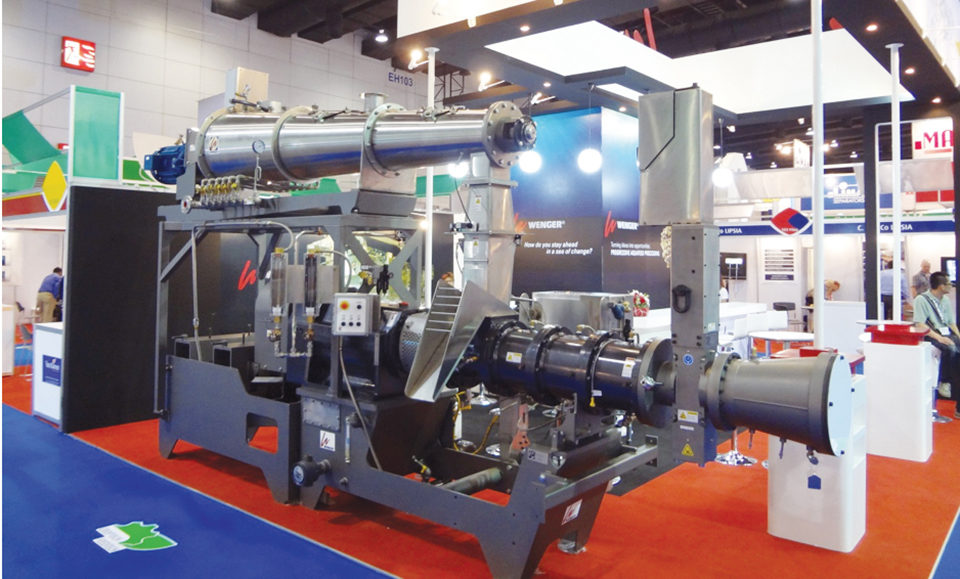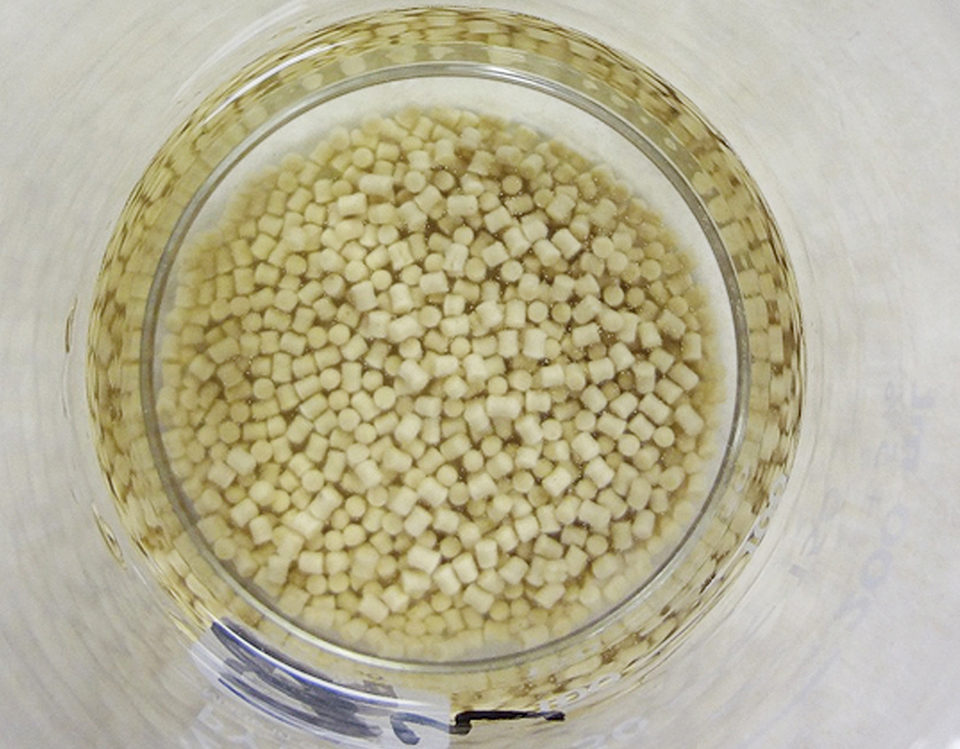Ingredients of lower protein content can be included

Shrimp feed production by extrusion cooking has developed into a solid method. Recent advancements in this technology include higher feed production capacity, smaller pellet sizes, a wider range of ingredient options and development of amino acid fortification.
Advanced die technology
Higher production capacities have been made possible by the development of advanced die technology. The limiting factor – open area in the die – was eliminated by use of the patented oblique tube die that increased rates by three to five times. By virtue of a pressure drop, the tubes also elevated density into the low 700 g/L range. Capacities now vary 8-10 mt/hour via extrusion cooking.
Extrusion cookers can easily make feeds with diameters smaller than those from pellet mills. Feeds down into the 0.6- to 0.8-mm range are possible, with some manufacturers making even smaller feeds. It is difficult to hold pellets smaller than 0.8 mm on a standard perforated dryer bed. Fluid bed dryers are required below 0.8 mm.
Common sense says that the smaller the pellet, the more pellets per kilo. In pond settings, this could relate to simply more pellets per feeding. In the case of an indoor stacked raceway system, such as that developed by Dr. Addison Lawrence of Texas A & M, smaller-diameter pellets allow feeding more times per day while not exceeding the general percentage fed based on the biomass in the system.
Experiments have shown that shrimp eat more continuously in indoor raceways. Water flow can be controlled in a manor to spread the feed across the system. Automatic feeding systems can effectively introduce feeds at the desired intervals in these close-quarters systems.
Shrimp diets
The Pacific white shrimp, Litopenaeus vannamei, has become a major species raised in cultivation around the world. Through many studies and experiments, it has been proven that a high level of fishmeal is not needed in their diets. Vegetable proteins are quite acceptable as long as all nutritional factors have been met.
Extruders require a lower level of starch than pellet mills to bind vegetable proteins with other ingredients in feed formulations. Ten percent starch is sufficient for sinking feeds in extruders, which leaves 90 percent of the formula to achieve inclusion of protein and other needed nutritional elements. Soybean meal generally is about 44 or 48 percent protein, and fishmeal is 65 percent protein. Pellet mills require 25 to 30 percent starch to hold pellets together.
The statement that extruders can work with a wider range of ingredients simply means ingredients of lower protein content, such as soybean meal and other vegetable proteins in the case of L. vannamei, can be included to achieve a total protein level without having to solely rely on fishmeal. Of course, some fish product is included for a complete amino acid profile, but using less can greatly reduce the cost of feed.
Another point sometimes overlooked is the ability of extrusion cookers to handle a level of liquid inclusion, such as ground-up fishery by-products. Nutritionists can likely imagine possibilities for including 15 to 30 percent fresh aquatic waste from squid or other species in feed. A product that has not been double-processed such as fishmeal is more attractive to shrimp.

Essential amino acids
Various options are available to achieve good amino acid profiles in feed when using vegetable proteins. Essential amino acids are not optimal in plant proteins, and it is not that feasible to use crystalline amino acids to fortify feeds to be placed in water. The added amino acids leach out and do not make it into animals’ guts when needed to create the conversion into body mass. One effective solution is to bind the amino acids to the vegetable protein, but until recently, the cost of doing so was prohibitive.
The injection of engineered liquid into the extruder achieved the goal. Many trials by the author were conducted to achieve the right process conditions to bind the desired amino acids to the vegetable protein. The results showed that with injection of crystalline methionine, plant protein digestibility was increased, a threefold increase in the amino acid content was achieved and, most importantly, more than 99 percent of the amino acid included was attached.
The growth rates of shrimp given this formulation bound with methionine were equal to those of L. vannamei that received crystalline methionine in feed.
Perspectives
Additional studies are planned for other vegetable proteins. Tests with lysine confirmed it can be bound to vegetable proteins in aquafeed. Taurine presents additional possibilities for applications in marine fish sectors.
Extrusion is showing further promise as the industry develops and moves forward to lower fishmeal usage while maintaining current levels of production.
(Editor’s Note: This article was originally published in the July/August 2013 print edition of the Global Aquaculture Advocate.)
Author
-
Joseph P. Kearns
Aquaculture Process Engineering Manager
Wenger Manufacturing, Inc.
714 Main Street
Sabetha, Kansas 66534 USA
Tagged With
Related Posts

Aquafeeds
A look at the SME controlled extrusion process
A study was conducted using a Twin-Screw Extruder equipped with Specific Mechanical Energy (SME) and Density Control valves, to determine the effect of SME on the water stability of shrimp feeds. Further research is needed to evaluate the performance.

Health & Welfare
Amino acid supplementation reduces protein levels in pangasius diets
Trials show that supplementation with amino acids could reduce protein levels from a typical 28 percent to 23 percent in pangasius diets.

Aquafeeds
A look at phospholipids in aquafeeds
Phospholipids are the major constituents of cell membranes and are vital to the normal function of every cell and organ. The inclusion of phospholipids in aquafeeds ensures increased growth, better survival and stress resistance, and prevention of skeletal deformities of larval and juvenile stages of fish and shellfish species.

Health & Welfare
Aiding gut health with a natural growth promotor
A study with Nile tilapia conducted in commercial production cages in Brazil showed the potential – in the absence of major disease threats – of a commercial, natural growth promotor that modulates the microbiota (inhibiting growth of pathogenic bacteria and promoting growth of beneficial bacteria) and inhibits quorum sensing.


